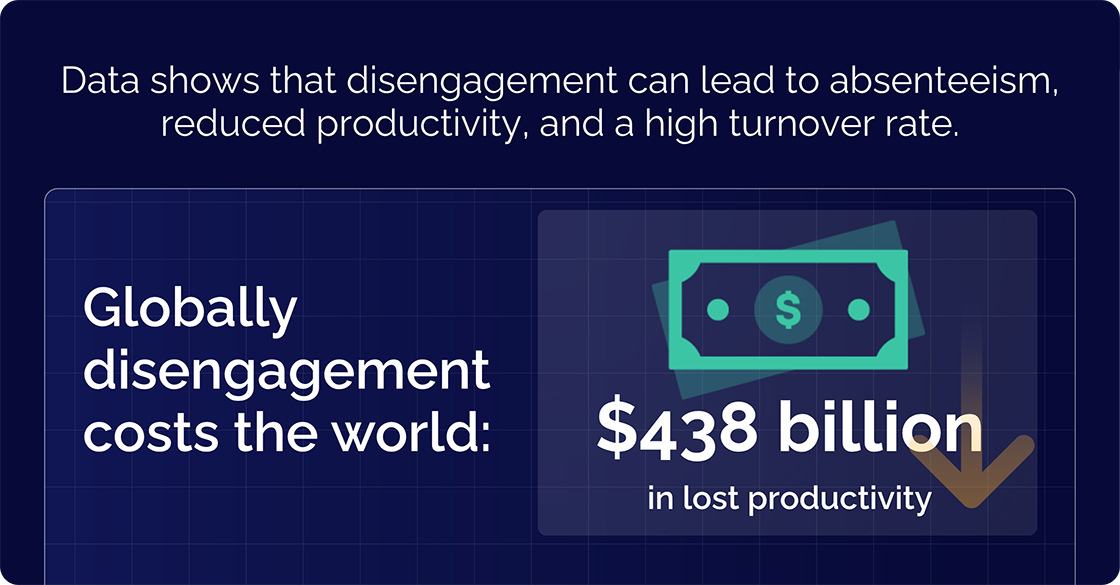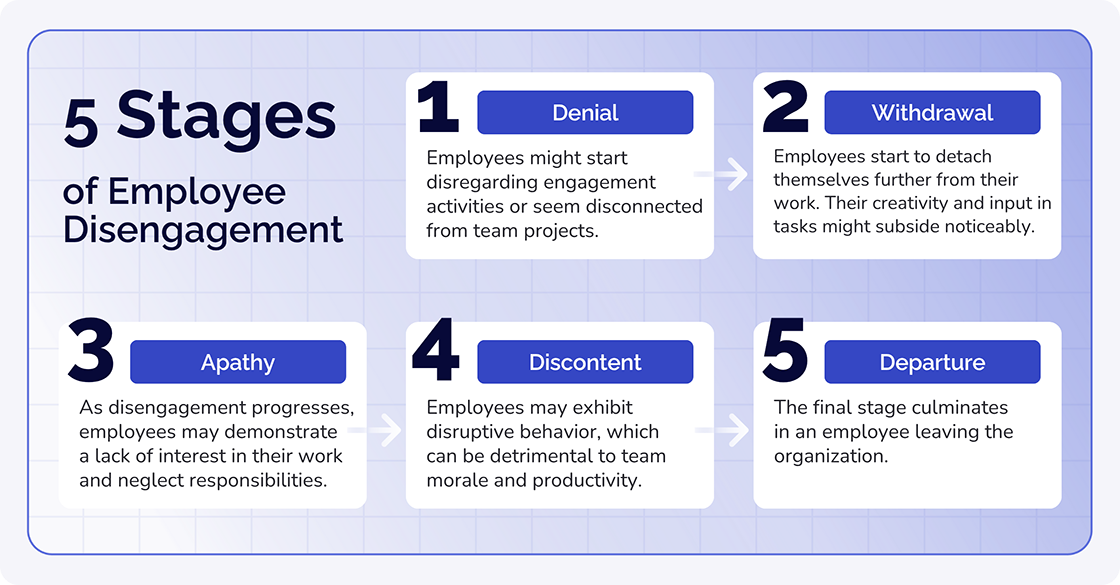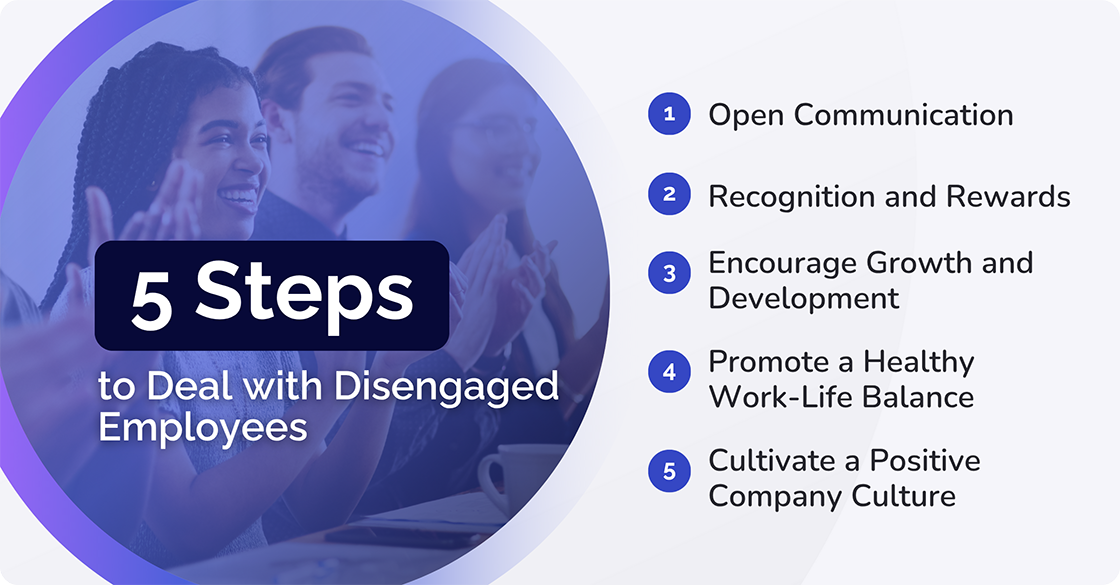There’s lots of talk about employee engagement — but not much about the killer, employee disengagement. Learn why disengagement affects 79% of the workforce.

.png)
It can be difficult to know what to include in an employee survey. That’s why we have created a template that you can use for FREE to ensure your employee surveys are engaging. Get the responses that will help you understand your audience.
Access Now
Gallup’s State of the Global Workplace 2025 Report warns that employee engagement is on the brink, having fallen two percent in 2024. This is alarming since it is only the second time in 12 years that engagement has fallen. Last year’s drop from 23% to 21% equates with the two-point drop in engagement during 2020 when the workplace was dramatically affected by COVID-19 lockdowns and shelter-in-place orders. What it means is that disengagement has risen from 77% to 79%, with 62% of employees not engaged and 17% actively disengaged. And there’s no indication that it’s getting any better.

The report also tracks global life evaluation based on how the world’s workers say their lives are going. The Gallup survey shows that it has fallen from 35% to 33% in the last two years.
However, the relatively good news for the U.S. and Canada is that engagement figures (31%) are, along with Latin America and the Caribbean, higher than anywhere else in the world. But only 52% are thriving, while 44% are struggling and 4%, suffering.
Similarly, U.S. and Canada life evaluation figures are also higher at 52%, with Australia and New Zealand topping the list at 56%.
Interestingly, while employee engagement in Europe is reportedly a dismal 13% (which means disengagement is at an all-time high of 87%), they rank fourth, after the U.S. and Canada, with a life evaluation figure of 47%.
Contrary to employee engagement, disengagement reflects an emotional, cognitive, and behavioral state of disconnect that exists when an employee fails to commit fully to their role, company culture, or the organization’s goals. It is generally viewed as an uncommitted, unproductive state because it significantly affects the attitude and conduct of each employee who is disengaged. It’s opposed to efficiency, productivity, and workplace positivity, often leading to negative outcomes.
On the other hand, employee engagement reflects the enthusiasm and involvement of employees. When they are engaged, they are more productive at work and absent less. Furthermore, engaged employees are less likely to say they experience negative emotions, including stress.
Gallup’s global summary in the 2025 report breaks down employee engagement in three ways: engaged, not engaged, and actively disengaged. It draws a clear distinction between active disengagement and a less pronounced lack of engagement.
For this reason, an employee who is “not engaged” mustn’t be confused with an employee who is “actively disengaged”. There is a fundamental difference between the two terms that Gallup quotes. While not engaged employees (who may be seen as disengaged) are less enthusiastic and give fewer contributions, actively disengaged employees deliberately tend to undermine the company’s progress and/or the accomplishments of those around them.
In addition to the breakdown of engaged, not engaged, and actively disengaged employees, Gallup data also measures emotions, showing that stress is the most common:
All these emotions negatively impact engagement.
We have seen from Gallup’s 2025 stats that actively disengaged employees make up 17% of the workplace population. These employees are open about the fact that they dislike their jobs and let this be known. They commonly make negative comments about the workplace and speak negatively about it outside of the workplace.
However, the largest sector comprises those who are simply not engaged, and the danger is that they might become actively disengaged.
Another statistic presented by Gallup is that more than half of employees are either watching out for a new job or actively seeking one. The issue is that organizations aren’t meeting employees’ needs. Employees don’t just want a job, they want the opportunity to thrive on all levels. It’s up to employers and team leaders to ensure that they are given opportunities. This will increase employee engagement, but positive work experiences hardly ever happen by chance — “they are a product of purposeful leadership.”
“Designing and executing an effective employee experience strategy isn't easy — but it is worth it. It's what drives your key outcomes and promotes employee well-being. But it takes more than just an annual employee engagement survey to implement.”
Gallup
There are a multitude of possible reasons for employee disengagement. An intriguing point that Gallup’s State of the Global Workplace 2025 Report raises is that it's only the second time in 12 years that engagement has dropped. The decrease in 2020 was linked directly to the pandemic and is understandable. But why the drop in 2024?
Gallup blames the 2024 decrease in engagement on manager disengagement, and the fact that 56% of managers surveyed say they haven’t received management training. In fact, the report states that individual contributor engagement has remained flat. But managers are employees too, and their declining engagement has made a huge impact in the workplace.
The reality is that if managers are disengaged, their teams and departments will be too. Gallup stats show that the countries with less engaged managers also have less engaged individual employees.
“If manager engagement continues to decline, it won’t stop with managers, and it won’t stop with engagement. The productivity of the world’s workplace is at risk.”
Gallup
A lack of training appears to be a very real issue. So, their primary suggestion to cut this extreme disengagement is to ensure that all managers receive training. Evidence shows that half as many managers who receive training are actively disengaged when compared with those who are not trained.
Other ways to increase manager engagement include:
When managers thrive, so do their teams.
Craft effective surveys to measure employee sentiment and boost engagement
.png)
Costs are a critical issue that most businesses overlook when it comes to disengagement. Actively disengaged employees can take a substantial toll on an organization’s financial health. They aren’t merely unproductive team members, but they often negatively influence their colleagues, generating a domino effect of plummeting morale and low employee engagement.
Data shows that disengagement can lead to absenteeism, reduced productivity, and a high turnover rate. Gallup’s State of the Global Workplace 2025 Report also reveals that disengaged employees cost the world an incredible US$438 billion in lost productivity alone. This kind of number is alarming and illustrates the urgency needed to address the issue.

A disengaged employee can impact all aspects of the business, including customer satisfaction, reputation, and most importantly, the bottom line. Yet, it’s not just about the direct financial consequences. There are indirect costs too. These include recruitment expenses for replacing disengaged employees, resources spent on training new hires, and the potentially negative impact on company culture. Therefore, it’s crucial not to underestimate the cost of disengagement.
Identifying signs of disengagement at an early stage is a challenge for the management of any organization. However, knowing what to look for can be advantageous when it comes to curbing disengagement. Here are six signs to look out for:
Any change in attitude can be a key indicator that an employee is disengaged. They might express dissatisfaction, or pessimism, or display a significant drop in enthusiasm about their work or the organization.
Disengaged employees often show low productivity levels. As they lose interest in their roles, the quality and quantity of their work may decline.
Disengaged employees often distance themselves from team members and work conversations. This lack of social engagement can adversely impact the team’s morale and collaboration. It may also be an indication of an increasingly negative attitude to the company.
Unwillingness to take up new tasks beyond their regular job description or to contribute to team meetings and discussions could be a sign of increasing disengagement.
Frequent leave of absence, late arrivals, or early departures could point to an employee being disengaged from the firm. According to Gallup’s Q12 survey, engaged employees tend to have 78% fewer absent days compared to their disengaged colleagues. The result of this absenteeism can disrupt workplace productivity and team morale.
Employees who resist changes in the organization or their role may be disengaged. According to The Grossman Group, when employees resist change, “they often become less efficient or effective in their roles.”
Often, deciphering these signs requires constant observation and communication skills. However, correct identification facilitates intervention and allows for steps to enhance employee engagement. Though it may seem challenging, recognizing symptoms is the first step towards addressing disengagement and minimizing it in the workplace.
Craft effective surveys to measure employee sentiment and boost engagement
.png)
The prevalence of disengagement in the workplace is a concern that managers and business leaders cannot afford to ignore. Recognizing the stages of disengagement is crucial in addressing the issue before it festers and causes lasting damage to both the employee and the organization.
A McKinsey & Company article, How to identify employee disengagement, states that their research reveals more than half of employees are disengaged and/or dissatisfied. “That’s a big percentage that strikes at the heart of value creation for organizations that are already facing rising labor costs and declining worker productivity.”
Their suggestion is for managers to figure out where employees fall along the satisfaction spectrum they have revised: thriving stars, reliable and committed, double-dippers who hold more than one job at a time, mildly disengaged, disruptors, or quitters. A short survey can help you discern who fits where:
Identifying their disengagement by behavior and attitude can also be invaluable, because it generally follows a pattern.
The first stage of disengagement often manifests subtly. Employees might start disregarding engagement activities or seem disconnected from team projects. However, they often deny feeling unfulfilled or dissatisfied when asked directly.
At this stage, employees start to detach themselves further from their work. Their creativity and input in tasks might subside noticeably, and they may begin to withdraw from team members and workplace social activities.
Apathetic employees demonstrate an entrenched lack of interest in their work. As disengagement progresses, they may neglect responsibilities and display a negative attitude. It’s at this stage that actively disengaged employees usually become evident.
Once dissatisfaction transforms into discontent, employees may exhibit disruptive behavior, such as spreading negativity, which can be detrimental to team morale and productivity.
The final stage culminates in an employee leaving the organization. This can often result from a total lack of engagement, causing the employee to look for fulfillment elsewhere.
Proactive, employee-centric policies can help address symptoms of disengagement and energize disengaged employees.

Disengagement presents profound ramifications within the workplace, affecting varying aspects ranging from employee experience to attrition and overall productivity.
Disengagement drastically affects employee experience. When employees are disengaged, they often experience burnout, under-stimulation, and a lack of personal growth. This dissatisfaction can bleed into their general outlook toward the workplace, tarnishing the overall employee experience.
Studies show that organizations marked by low employee engagement frequently fight against high stress levels, poor work-life balance, and an absence of recognition. This lackluster experience invariably reinforces disengagement, creating a vicious cycle that has hugely negative effects.
Disengaged employees are more likely to leave an organization. Attrition rates have a direct correlation with engagement levels, and the cost of losing a great employee extends beyond financial implications.
Gallup’s report states that manager burnout leads to declining performance, increased absenteeism, and increased turnover, impacting the people they lead and the organization itself.
Their Q12 survey referenced above reports 21% less turnover in high-turnover organizations and 51% less turnover in low-turnover organizations when employees are highly engaged.

Productivity takes a massive hit when employees disengage. Engaged employees bring energy, commitment, and innovation to the workplace — all attributes that drive productivity. Conversely, disengaged employees often perform minimally, leading to reduced output and quality of work.
Gallup’s Q12 survey also reveals that companies with higher engagement levels are 23% more profitable. This demonstrates that engagement narrows down to the bottom line. Ultimately, low productivity from disengaged employees can significantly diminish an organization’s competitive advantage.
The impact of disengagement far exceeds the disruption of individual employees. It breeds a negative company culture that can compound over time. Therefore initiatives to identify and address disengagement should be a top priority for every organization.
If faced with actively disengaged employees or signs of disengagement within your workforce, the good news is that there are healthy and constructive strategies to re-energize. By leveraging the right strategies, you can transform disengaged employees into productive and enthusiastic team members.
Communication is a key factor for any employee’s engagement level. An environment where employees feel comfortable discussing their needs and concerns is good for morale. Regular feedback and discussions about their performance can also make them feel valued and heard. Providing platforms for open communication helps to foster a great employee experience and prevent employees from disengaging.
Employee recognition is another effective strategy for reviving a disengaged employee. Recognizing their efforts and achievements can motivate, boost their morale, and promote positive behavior. Accompany recognition with tangible rewards like bonuses, promotions, or even opportunities for continuing education to further enhance their engagement level.
Providing the opportunity for employee growth maintains engagement and generally prevents employee burnout. Regular workshops, skills training, conferences, or certifications are examples of ways to stimulate employee growth. Employees appreciate this as it shows the organization’s investment in their potential, thereby boosting their loyalty and engagement.
Overworking is one of the causes of disengagement, primarily because it is a sign that it can lead to burnout. Employees need frequent breaks and ample time for non-work activities. Encourage a balanced life by being flexible about work hours, providing adequate vacation time, and promoting mental health support. This fosters a healthy work-life balance and can re-energize disengaged employees.
There is no doubt that a positive company culture where employees feel valued and respected is key to employee engagement. This is why it’s so important to focus on creating an atmosphere that nurtures collaboration, trust, and transparency. Involve leadership in demonstrating this culture to ensure it permeates the entire organization. Remember, a great employee is likely to disengage in a negative environment, so maintaining a healthy workplace culture is pivotal.
Following these strategies can significantly increase employee engagement metrics. It allows disengaged employees to regain their enthusiasm for work and contributes to the overall growth and development of the organization.

Communication is key to employee engagement, and the most effective way to boost engagement is through a strategic internal communications plan.
Cerkl Broadcast delivers a powerful, all-in-one internal communications platform built on AI and designed for internal communicators. Whether you're a small team or a global enterprise, Broadcast scales to meet your needs, offering a centralized hub to organize, manage, and distribute content efficiently.
Built with flexibility in mind, the platform’s omnichannel delivery ensures your messages reach employees where they are, via their preferred channel — e.g. email, mobile, intranet — without requiring you to manually manage distribution. Employees choose how they want to receive updates, improving accessibility and engagement across on-site, remote, and international teams.
With dynamic audience segmentation, personalized content delivery, real-time analytics, and automated scheduling, Broadcast’s Audience Manager empowers communicators to send the right message to the right person at the right time. Everything is backed by insights that help you measure impact and continuously optimize your internal communication strategy.
Are your employees disengaged? If you think they are engaged, how certain are you that they are? The best way to find out is by undertaking a survey. We know that this may seem like a daunting task. But it doesn’t have to be. We have designed an employee engagement survey template that you can use as is, or adapt to fit your needs 100%. It’s free for you to download right now.
.png)
Craft effective surveys to measure employee sentiment and boost engagement
What is employee disengagement? This refers to a state in which employees feel disconnected, uninvolved, or indifferent to their work, leading to decreased motivation and productivity.
What causes employees to be disengaged? Disengagement is characterized by a lack of emotional commitment and enthusiasm towards one’s job. This results in reduced job satisfaction and organizational loyalty.
How do you handle a disengaged employee? To address disengagement, organizations can implement strategies such as open communication, providing opportunities for skill development, and recognizing and rewarding achievements. Offering a supportive work environment and seeking feedback to understand and address underlying issues are also good approaches.
What happens if employees are disengaged? If employees are disengaged, organizations may face reduced productivity, increased absenteeism, higher turnover rates, and a negative impact on overall workplace morale and culture. Disengagement can also lead to a decline in employee satisfaction and hinder the achievement of organizational goals.
What are the three levels of disengagement? The three levels of disengagement often referred to are actively disengaged (employees who are openly negative and disruptive), passively disengaged (those who are physically present but mentally checked out), and engaged (employees who are committed, motivated, and contribute positively to the workplace). These levels serve as a foundational framework for understanding the spectrum of employee commitment and involvement in the workplace.

Craft effective surveys to measure employee sentiment and boost engagement